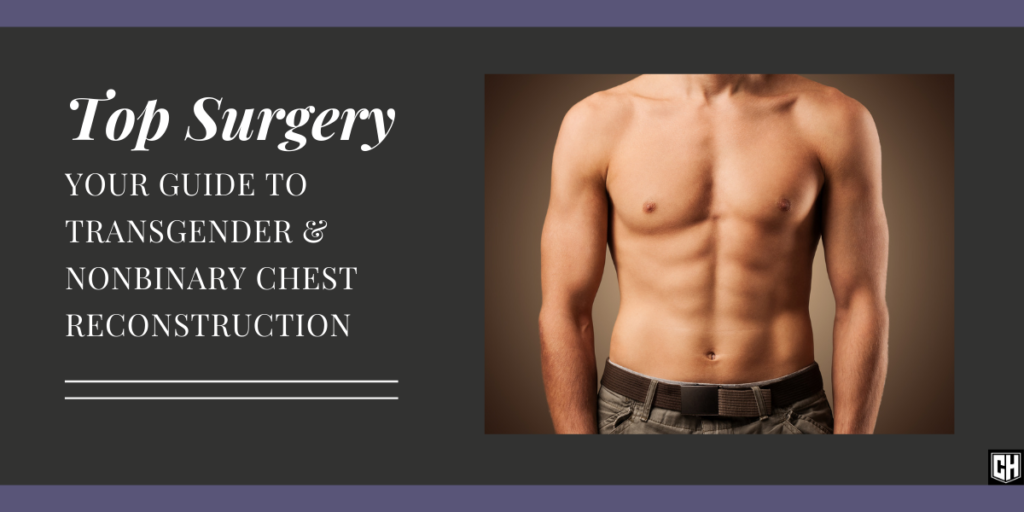|
|
For some of the 1.4 million American adults who identify as transgender, top surgery is a way of obtaining the form that matches their gender identity, rather than the gender they were assigned at birth.
You may have heard of top surgery referred to as transgender chest reconstruction or gender-affirming surgery. Regardless of the name, the procedure follows a similar approach.
What is Top Surgery?
Top surgery is a way for transgender and nonbinary patients to reshape their chests, so that what they feel on the inside can be visible on the outside. It can be a way to quiet gender dysphoria, which some transgender and nonbinary people feel. Gender dysphoria is a discomfort experienced when one’s body doesn’t wholly align the gender with which they identify.
Of course, not all trans people feel drawn to undergo surgery—it’s a personal decision, not one that is required.
For transgender men and nonbinary patients, top surgery can be an effective way to reconstruct the chest to appear flatter and more masculine. For nonbinary people, the surgeon may take steps to make the chest appear more gender neutral.
Similarly, transgender women can change the look of their chests too, and many do. However, most will see natural curves form when they start taking estrogen.
Types of Top Surgery
There are multiple ways for transgender men and nonbinary folks to alter the look of their chests. Most commonly, these procedures involve a mastectomy, during which the breast tissue is removed. The surgeon may also re-contour the area so that the pecs are more pronounced.
There are a few different surgical methods that doctors commonly use.
A double incision approach is often deployed for trans men with larger chests. This procedure can take between three and four hours and creates visible scars across the chest. Of course, these scars fade dramatically with time. Additionally, if the patient’s pec muscles become well-developed in the months or years post-surgery, these scars will tend to “fit” naturally into the contour of the pec muscles.
With a double incision approach, the surgeon removes the breast tissue and excess skin, as well as excises the nipples, resizes them, and places them back on the chest in the desired position. The end result is a look that matches a more “male” or “masculine” physique. Liposuction may also be performed.
The main benefit of this surgery is that it provides the freedom to shape and sculpt the chest as the patient desires.
A periareolar top surgery results in less scarring, but it only works for trans men with smaller chests. It retains more nipple sensation than the double incision procedure and the only visible scars are directly around the nipples, which makes them discreet.
With this procedure, the surgeon removes a “ring” of skin around the nipples to flatten and “pull in” excess skin. The procedure also includes removal of the breast tissue (a mastectomy), and potentially, liposuction to flatten out the contour of the chest.
Keyhole surgery works for a small number of trans men who have very small chests and little excess skin. It requires the shortest surgery— 90 minutes to three hours—and results in the least amount of scarring. The only visible scar is a partial scar around each nipple, which is barely visible in the years after surgery.
Preparing for Top Surgery
Your doctor will tell you how to prepare for top surgery. In most cases, prep will be similar to that of any other procedure. For example, you may not be able to eat or drink for a certain amount of time before you go under.
You must wear loose-fitting clothing to your top surgery so that you can put on the same comfortable clothes afterward. Many top surgeries are outpatient procedures, meaning you’ll go home once you’re finished. So, dress thoughtfully on the day.
Trans men may be asked to take a pregnancy test before surgery, which can trigger feelings of gender dysphoria. Not all doctors understand or are adept at dealing with this, so try and have a conversation before the procedure to understand what will be expected of you.
With the current COVID pandemic, you may also be asked to take a COVID test in the days prior to your procedure.
Finally, you should know the top surgery costs you’ll have to pay. Most procedures cost between $7,000 and $10,000, with surgeon and anesthetic fees included. Travel expenses might push your costs over that benchmark, though.
Currently, only a small number of top surgeons accept health insurance.
A Better Understanding of “What Is Top Surgery”
Perhaps this information has galvanized your desire to have top surgery. Perhaps it has not. Either way, the decision is powerfully and uniquely yours—and our community is behind you every step of the way.
Want to learn more from Cade, who is LGBTQ and nonbinary?
Join a million other readers who are learning Cade’s secrets, like increase income, invest for cash flow, increase confidence, or lose 10 pounds, fast.
